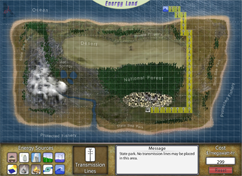Energy Land

The need for more electricity continues to grow as people demand a greater number of appliances and devices that use energy. City officials face difficult decisions as to which type of energy source should be used to supply a town’s electrical energy needs. All energy sources have benefits and drawbacks associated with their use. Which energy source would you choose to supply your city’s electricity needs?
What are some traditional energy sources?
For the past century, the U.S. has primarily relied on fossil fuels, which include coal, natural gas, and petroleum products to be the major supplier of energy to meet the needs of the people. The relatively low cost of fossil fuels and their ease of use has made them the energy source of choice with most people. However, since fossil fuels are a limited, nonrenewable resource and are often associated with some levels of environmental damage, the need to find and use alternative energy sources has accelerated over the past few decades. Coal Coal is mainly composed of carbon in the solid form. Coal has a relatively low cost, high energy content, and when combined with oxygen in the combustion process produces heat. The heat is used to convert water to steam that spins turbines that generate electrical energy. The U.S. has abundant reserves of coal. A downside of coal combustion is the production of waste products, such as carbon dioxide and sulfur oxides that can contaminate the environment. Natural gas Two hydrocarbons, methane and ethane, are the major parts of natural gas found in homes. These hydrocarbons can be combusted and produce large amounts of heat. Many U.S. power plants, home water heaters, and home heating systems rely on natural gas to supply their energy needs. The U.S. also has large reserves of natural gas that can provide low-cost energy. Natural gas generally burns cleaner than coal and produces fewer waste products; however, significant amounts of carbon dioxide are released during the combustion process.What are some alternative energy sources?
A number of alternative sources have been suggested and researched to supply the energy needs of communities. These include nuclear power plants, wind turbines, solar cells, geothermal systems, biomass plants, hydroelectric, and tidal variations power systems. All of these systems have both advantages and disadvantages that must be compared against traditional energy sources. Nuclear reactions Nuclear power is an alternative to traditional fossil fuels as an energy resource. Nuclear power is produced using fission reactions, where a larger atom is changed into two or more smaller atoms. This process releases large amounts of heat, which they can be used to produce electrical power in the same manner as the fossil fuels. Vast quantities of energy can be released from relatively small amounts of fission materials. However, high construction and maintenance costs of facilities and the need for sophisticated waste disposal methods make this form of energy production less desirable. Wind turbines Wind power relies on the unlimited natural resource that blows across almost every location on Earth: wind. Wind turbines use the energy associated with moving air to turn a large blade, which in turn spins a generator that makes electrical energy. Although this energy source appears to be free because wind is an unlimited natural resource, high costs are associated with the construction and maintenance of the turbines. Many people also object to the wind turbines being placed in their area due to their unsightly appearance and the noise created by the spinning blade. Solar Cells Photovoltaic cells are often referred to as solar cells. Solar cells directly convert sunlight into electrical energy. Since sunlight is an unlimited resource, solar cells are a relatively inexpensive way to produce electrical energy. The cost of making solar cells has dropped significantly over the past couple of decades, and has reached a point where many U.S. homes supplement their energy needs using solar power. Current limitations of solar power include the large collection areas required for the solar panels, and solar cells located in regions that have limited sunny days may not operate at efficiencies high enough to supply energy demands. Geothermal Vast pockets of hot materials lie below the surface of Earth. Liquid water that is trapped in rock adjoining these hot regions is heated and converted to steam. These steam reservoirs can be tapped and the steam used to spin turbines, which in turn generate electricity. Two major problems associated with using geothermal energy are that not all areas have geothermal pockets that can be tapped, and often many of the regions that do offer access are located great distances from the populations with the electricity needs. Power transmission lines that run great lengths often result in large energy "losses" along the line when the desired electrical energy is converted to waste heat. Biomass Biomass power plants produce energy via the combustion of typical yard waste, trash, and timber sources. These materials are burned to make heat that converts liquid water to steam and is used to spin a turbine to generate electricity. Since timber is a renewable, limited resource, these plants can operate long-term without having to worry about running out of fuel. Disadvantages of these plants include environmental and noise pollution. Hydroelectric Moving water can be used to spin turbines to generate electricity. The faster the water moves, the more electricity can be generated by the turbines. For this reason, hydroelectric power plants are often located in areas where water can be stored in lakes and then allowed to fall to a river at a much lower level than the storage lake. Since larger amounts of moving water are needed to supply the movement of the turbines, hydroelectric power plants are limited in their geographic placement.Walkthrough
Tier 2 Lessons: Grades 7 - 12+
You need to log in to access this simulation.



